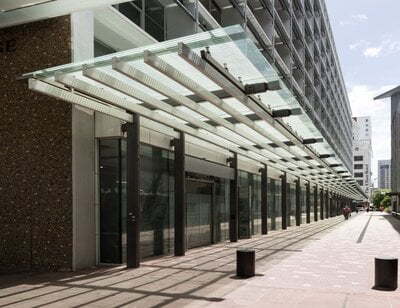In a recent article we discussed what happens with our aluminium waste, before digressing to cover the recyclability of aluminium and its general environmental impact. Now we’d like to turn the sustainability spotlight on powder coating, as the majority of our louvres will be installed with a powder coating from either Dulux or Interpon. Which leads us to the big question: is powder coating environmentally friendly?
Air Pollution & Rule 66
To help answer the question, we turn to the history books to provide some context. In 1966, Los Angeles was smothered by the unintended consequences of a rapid period of population growth. As the City became a hotbed of people and industrial activity, the air became blanketed in a thick photochemical smog. The largest contributor to this smog was, of course, the motor vehicle. Yet 20% was down to the release of organic solvents into the atmosphere, some 600 tons per day on average.
Los Angeles County took heed of research demonstrating how organic solvent materials are highly reactive when irradiated in the presence of oxides of nitrogen, and how some had the potential to produce more ozone and eye irritation than vehicle exhausts. Partial oxidation of solvent effluent from solvent-using processes enhanced its photochemical reactivity and contributed significantly to the photochemical smog.
The leaders of the time had the foresight to do something about this and talked about what would happen by 1980 or 1990 if they didn’t. The answer was detailed in ‘Rule 66 of the Los Angeles County Air Pollution Control District’.
We share this not just because it’s interesting (to us anyway) but because it’s partially responsible for the advancement and widespread adoption of powder coating. From the very start, one of the driving considerations for powder coating was how to make it safe and better for the environment than the alternatives. So is it?
Powder Coating is Solvent-Free and Reduces Volatile Organic Compounds (VOCs)
There is a relatively common misconception that powder coating is simply a form of dry paint that is sprayed and then cured, therefore a powder coating must include solvents in the ingredients list. It doesn’t and powder coats are solvent free.
This is important because solvents really aren’t that nice. They release VOCs into the atmosphere that are known to deplete the ozone layer and are detrimental to human, animal and plant health. Indeed, many solvents are toxic or carcinogenic, can pollute the air and water, and can lead to ground contamination.
Traditional liquid coatings are high in VOCs and these are released during the curing process. Not so with powder coating.
No Heavy Metals or Halogens
The other nasties missing from powder coatings are heavy metals and halogens. There is no lead, cadmium, arsenic or mercury. All of these present potential danger to humans. In fact, you may have heard the phrase ‘Mad as a Hatter’ before. While the etymology of the phrase is not abundantly clear, most agree it refers to hat makers who used mercury in the production of felt, and this use of Mercury was enough to turn the Milliners mad. Indeed, Boston Corbett (famous for shooting the assassin John Wilkes Booth dead) was described as being ‘as mad as a hatter’, which might not have offended him too much given that was actually his job. Boston ended up in an asylum from which he escaped, never to be seen again.
There is Virtually No Waste
Powder coating is an electrostatic process, where the charged particles are applied before being cured. When an overspray occurs, the excess powder coating particles can be recovered and recycled for future use. This prevents waste and also makes powder coating cost effective.
The powder reclamation process is most effective when only spraying one or two primary colours, as these have the most potential for future use, which makes collecting from filters or the booth floor a very worthwhile exercise.
Reduced Packaging
Every little bit helps and the reduction in packaging requirements for powder coating vs liquid spray might sound insignificant, but given the powder coating industry worldwide is worth upwards of USD$14 billion it might be surprising.
Energy Efficiency
Powder coat particles have a relatively low melting point, allowing them to be cured at a lower temperature, meaning powder coating requires less energy compared to conventional liquid coating methods.
A secondary advantage of that lower curing temperature (which we should point out is ‘comparatively lower’ and still very hot) means material can be powder coated without heat damage.
Powder Coating Has Serious Longevity
One of the reasons the Insol team enjoys working with powder coated aluminium is the ability to drive past a completed facade many years later and let everyone within earshot know that ‘we did that’, and being proud to do so because the facade still looks as good as it did at installation. Powder coats have some serious longevity.
For sustainability, that translates to a reduced need to maintain the facade. As the powder coated actually protects the metal finish, there’s also a reduced need for reapplication. It’s hard to calculate how much this saves in terms of both dollars spent and the energy requirements, but it’ll add up over the total life of the facade.
Reduction in Hazardous Waste
With no solvents or thinners used in the powder coating process, there is no accumulation of hazardous waste that needs disposing of. Further, the handling and storage process is simplified and there is a reduced threat to the environment in case of spillage.
Interestingly, the process of the disposal of liquid paint calls for the paint to be left exposed to oxygen so it can harden. Even this is problematic, as the drying process releases VOCs into the atmosphere. So using traditional liquid paints and even disposing of them properly can be harmful to the environment. It’s another reason powder coating is seen and considered as a ‘green option’.
A Note on Pre Treatment
It would be remiss not to mention the pretreatment process for powder coating as you cannot go without it, and any finished product is only as good as the pre-treatment. So it’s pretty important then. Historically, chromate chemicals have been used in the pre-treatment process. These have known carcinogenic properties and are being phased out in favour of the more environmentally friendly Oxaline pre-treatment, such as ws used for the recent Altus Warehouse project.
In conclusion, much like aluminium has sustainable properties that make its use advantages as the world moves to a more earth-friendly built environment, so does powder coating. It’s rare for both the base material (aluminium) and the finishing product (powder coating) to exhibit such environment friendly credentials. Further, they both allow for a degree of creative freedom that would otherwise be restricted and curtailed if trying to design a facade from anything else.
It makes for a winning combination for the environment and the architect.








